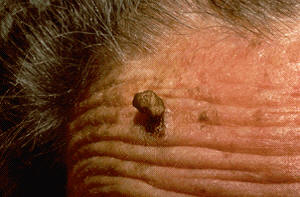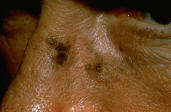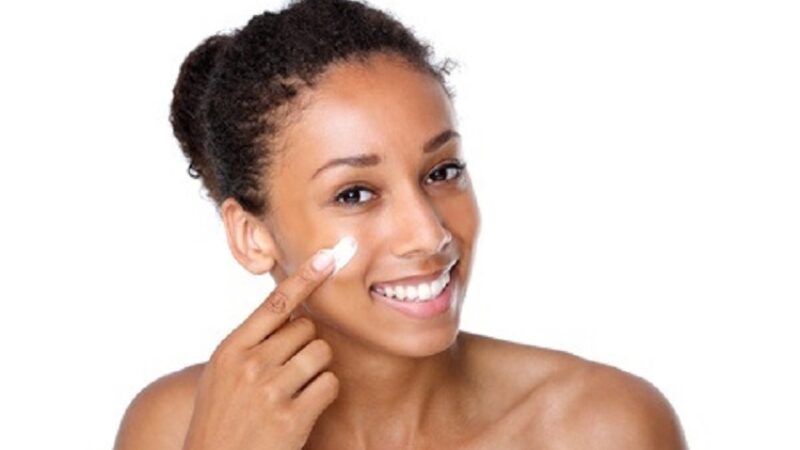*images American Academy of Dermatology
An actinic keratosis (plural keratoses), also known as solar keratosis, is a common skin lesion. It’s one of the most frequent reasons that an individual consults a dermatologist. Though the main reason for seeking treatment is removal of the lesion for cosmetic reasons, many people are unaware that this is a potentially serious condition that can set the stage for a more serious skin condition like squamous cell carcinoma.
In this post we’ll define actinic keratoses (AKs) and look at treatment options.
What Does Actinic Keratoses Look Like?
Actinic keratoses appear as small patches of rough, dry and scaly skin on areas including the face, lips, ears, back of your hands, forearms, scalp and neck. The lesions themselves may not be visible but surrounding skin will usually show signs of sun damage, such as broken blood vessels, yellowish discoloration or blotchy pigmentation. The lesions develop slowly and usually cause no signs or symptoms other than a patch or small spot on your skin.
AKs can range in color from red to skin-colored or appear brown, gray or yellowish black. In some instances they may appear as brown patches, mistaking their appearance for age spots. Larger patches may resemble rashes and their size ranges from as small as a pinhead to larger than a quarter. AKs that develop on the lips are referred to as “actinic cheilitis: and look like dry, scaling lesions on the lower lip.
What Causes Actinic Keratoses?
Most AKs are caused by long term, unprotected exposure to the sun’s UV rays – they tend to develop in areas that receive the most amount of UV exposure. Because they occur after many years of unprotected sun exposure, they are often not noticed until individuals are in the 60s. However, they can appear at any age and dermatologists are starting to find them in younger patients, including teenagers.
Individuals with fair skin, blond or red hair, light colored eyes and those who’ve experienced intense exposure to the sun are at greatest risk of developing AKs.
Actinic Keratoses Treatment
Although most individuals seek treatment for cosmetic purposes, they do have the potential to develop into squamous cell carcinoma, a potentially life threatening form of skin cancer. For this reason, it’s extremely important to consult a dermatologist if you suspect you have AK or any new, changing or worrisome skin lesion.
Treatment options include cryosurgery (freezing), surgical excision, curettage (scraping) with or without electrosurgery (heat generated by an electric current) and topical medications. Retinoids, either by prescription or over the counter as found in Green Cream may help – check with your physician. Lasers, chemical peels, dermabrasion, and photodynamic therapy may also be used. A dermatologist will be able to advise on the best treatment options.
Your Best Strategy is Prevention
Practicing sun safety is your best bet in helping to avoid the development of AKs. Follow these basic guidelines:
- Avoid excessive exposure to sunlight. Stay out of direct sun exposure during peak hours (10 am – 4 pm)
- Use a broad spectrum UVA/UVB blocking sunscreen with an SPF of 30 or higher. Formulations like Anthelios sunscreens and Fallene Total Block provide protection from both the UVA and UVB rays of the sun. Use one every day, year round – it’s never too early to start using sunscreen.
- Wear protective clothing. Wide-brimmed hats, 100% UV blocking wrap around sunglasses and tightly knit clothing that covers arms and legs should be used.
In addition to reducing your risk of developing AKs, good sun habits can also help to:
- Reduce the signs of premature agingK
- Keep the body’s immune system strong (UV rays can weaken the body’s ability to fight against many diseases including cancer)
- Protect against development of cataracts and macular degeneration – one of the leading causes of blindness in people aged 65 and older.






